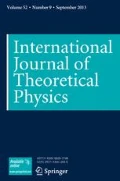Abstract
The idea of computational complementarity is developed further. A special class of macroscopic automata to imitate quantum and classical systems is described. The simplest automaton imitating a spin-1/2 particle is completely considered.
Similar content being viewed by others
References
Birkhoff, G. (1967).Lattice Theory, American Mathematical Society, New York.
Birkhoff, G., and von Neumann, J. (1936). On the logic of quantum mechanics,Annals of Mathematics,37, 823.
D'Espagnat, B. (1976).Conceptual Foundations of Quantum Mechanics.
Finkelstein, D., and Finkelstein, S. R. (1983). Computational complementarity,International Journal of Theoretical Physics,22, 753.
Gudder, J. S. P. (1983). A finite-dimensional quark model,International Journal of Theoretical Physics,22, 947.
Jauch, J. M. (1968).Foundations of Quantum Mechanics. Addison-Wesley Publishing Co, Reading, Mass.
Zapatrin, Z. (1988). Automata imitating classical and quantum physical systems. Quantum logic approach,Reports on Mathematical Physics (Warsaw).
Author information
Authors and Affiliations
Rights and permissions
About this article
Cite this article
Grib, A.A., Zapatrin, R.R. Automata simulating quantum logics. Int J Theor Phys 29, 113–123 (1990). https://doi.org/10.1007/BF00671321
Received:
Issue Date:
DOI: https://doi.org/10.1007/BF00671321




